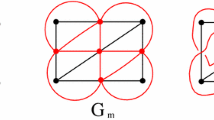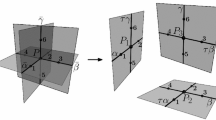Abstract
Motivated by the connection with the genus of the corresponding link and its application on DNA polyhedral links, in this paper, we introduce a parameter smax(G), which is the maximum number of circles of states of the link diagram D(G) corresponding to a plane (positive) graph G. We show that smax(G) does not depend on the embedding of G and if G is a 4-edge-connected plane graph then smax(G) is equal to the number of faces of G, which cover the results of S. Y. Liu and H. P. Zhang as special cases.
Similar content being viewed by others
References
Aigner, M. A Course in Enumeration. Springer Verlag, Berlin, 2007
Bollobás, B., Riordan, O. A polynomial of graphs on orientable surfaces. Proc. London Math. Soc., 83: 513–531 (2001)
Bollobás, B., Riordan, O. A polynomial of graphs on surfaces. Math. Ann., 323(1): 81–96 (2002)
Bondy, J.A., Murty, U.S.R. Graph Theory with Applications. American Elsevier Publishing Co., Inc., New York, 1976.
Cheng, X.-S., Jin, X. The braid index of complicated DNA polyhedral links. PLoS One, 7(11): e48968 (2012)
Cheng, X.-S., Liu, S.Y., Zhang, H.P., Qiu, W.-Y. Fabrication of a family of pyramidal links and their genus. MATCH Commun. Math. Comput. Chem., 63: 623–636 (2010)
Crowell, R.H. Genus of alternating link types. Ann. Math., 69: 258–275 (1959)
Endo, T. The link component number of suspended trees. Graphs and Combinatorics, 26: 483–490 (2010)
Gabai, D. Genera of the alternating links. Duke Math. J., 53: 677–681 (1986)
Godsil, C., Royle, G. Algebraic Graph Theory. Springer Verlag, New York, 2001
He, Y., Su, M., Fang, P., Zhang, C., Ribbe, A.E., Jiang, W., Mao, C. On the chirality of self-assembled DNA octahedra. Angew. Chem. Int. Ed., 49: 748–751 (2010)
He, Y., Ye, T., Su, M., Zhang, C., Ribbe, A. E., Jiang, W., Mao C. Hierarchical self-assembly of DNA into symmetric supramolecular polyhedra. Nature, 452: 198–202 (2008)
Hendrickson B. Conditions for unique graph realizations. SIAM J. Comput., 21(1): 65–84 (1992)
Jacobs, D. J., Hendrickson, B. An algorithm for two-dimensional rigidity percolation: the pebble game. J. Comp. Phys., 137: 346–365 (1997)
Jaeger, F. Tutte polynomials and link polynomials. Proc. Amer. Math. Soc., 103: 647–654 (1988)
Jiang, L., Jin, X., Deng, K. Determining the component number of links corresponding to triangular and honeycomb lattices. J. Knot Theory Ramifications, 21(2): 1250018 (2012)
Jin, X., Dong, F.M., Tay, E.G. Determining the component number of links corresponding to lattices. J. Knot Theory Ramifications, 18(12): 1711–1726 (2009)
Jin, X., Dong, F.M., Tay, E.G. On graphs determining links with maximal number of components via medial construction. Discrete Appl. Math., 157: 3099–3110 (2009)
Kim, D., Lee, J. Some invariants of pretzel links. Bull. Austral. Math. Soc., 75: 253–271 (2007)
Lin, C., Liu, Y., Yan, H. Designer DNA Nanoarchitectures. Biochemistry, 48(8): 1663–1674 (2009)
Lin, Y., Noble, S.D., Jin, X., Cheng, W. On plane graphs with link component number equal to the nullity. Discrete Appl. Math., 160: 1369–1375 (2012)
Liu, S.Y., Zhang, H.P. Genera of the links derived from 2-connected plane graphs. J. Knot Theory Ramifications, 21(14): 1250129 (2012)
Mphako, E.G. The component number of links from graphs. Proc. Edinb. Math. Soc., 45: 723–730 (2002)
Murasugi, K. On the genus of the alternating knot, I, II. J. Math. Soc. Jpn., 10: 94–105, 235–248 (1958)
Murasugi, K. On a certain numerical invariant of link types. Trans. Amer. Math. Soc., 117: 387–422 (1965)
Murasugi, K. Knot Theory and Its Applications. Birkhauser, Boston, Inc., Boston, MA, 1996
Murasugi, K., Stoimenow, A. The Alexander polynomial of planar even valence graphs. Adv. in Appl. Math., 31: 440–462 (2003)
Nakamura, T., Nakanishi, Y., Satoh, S., Tomiyama, Y. The state numbers of a virtual knot. J. Knot Theory Ramifications, 23(3): 1450016 (2014)
Pisanski, T., Tucker, T.W., Žitnik, A. Straight-ahead walks in Eulerian graphs. Discrete Math., 281: 237–246 (2004)
Sarmiento, I. Transition polynomials. Discrete Math., 302: 254–266 (2005)
Seifert, H. Über das Geschlecht von Knoten. Math. Ann., 110: 571–592 (1935)
Shank, H. The theory of left-right paths. In: A. Penfold Street, ed. by W.D. Wallis, Combinatorial Math. III, Lecture Notes in Math. 452, Springer, Berlin, 1975, 42–54
Yamada, S. The minimal number of Seifert circles equals the braid index of a link. Invent. Math., 89: 347–356 (1987)
Zhang, C., Ko, S. H., Su, M., Leng, Y., Ribbe, A. E., Jiang, W., Mao, C. Symmetry Controls the Face Geometry of DNA Polyhedra. J. Am. Chem. Soc., 131: 1413–1315 (2009)
Zhang, C., Su, M., He, Y., Zhao, X., Fang, P., Ribbe, A. E., Jiang, W., Mao, C. Conformational flexibility facilitates self-assembly of complex DNA nanostructures. Proc. Natl. Acad. Sci. U.S.A., 105: 10665–10669 (2008)
Acknowledgments
We thank Professor Hongliang Lu and Dr. Weiling Yang for some helpful discussions.
Author information
Authors and Affiliations
Corresponding author
Additional information
This paper is supported by the National Natural Science Foundation of China (Nos 11271307, 11171279 and 11101174).
Rights and permissions
About this article
Cite this article
Jin, Xa., Ge, J., Cheng, XS. et al. The Number of Circles of a Maximum State of a Plane Graph with Applications. Acta Math. Appl. Sin. Engl. Ser. 37, 409–420 (2021). https://doi.org/10.1007/s10255-021-1020-1
Received:
Accepted:
Published:
Issue Date:
DOI: https://doi.org/10.1007/s10255-021-1020-1




